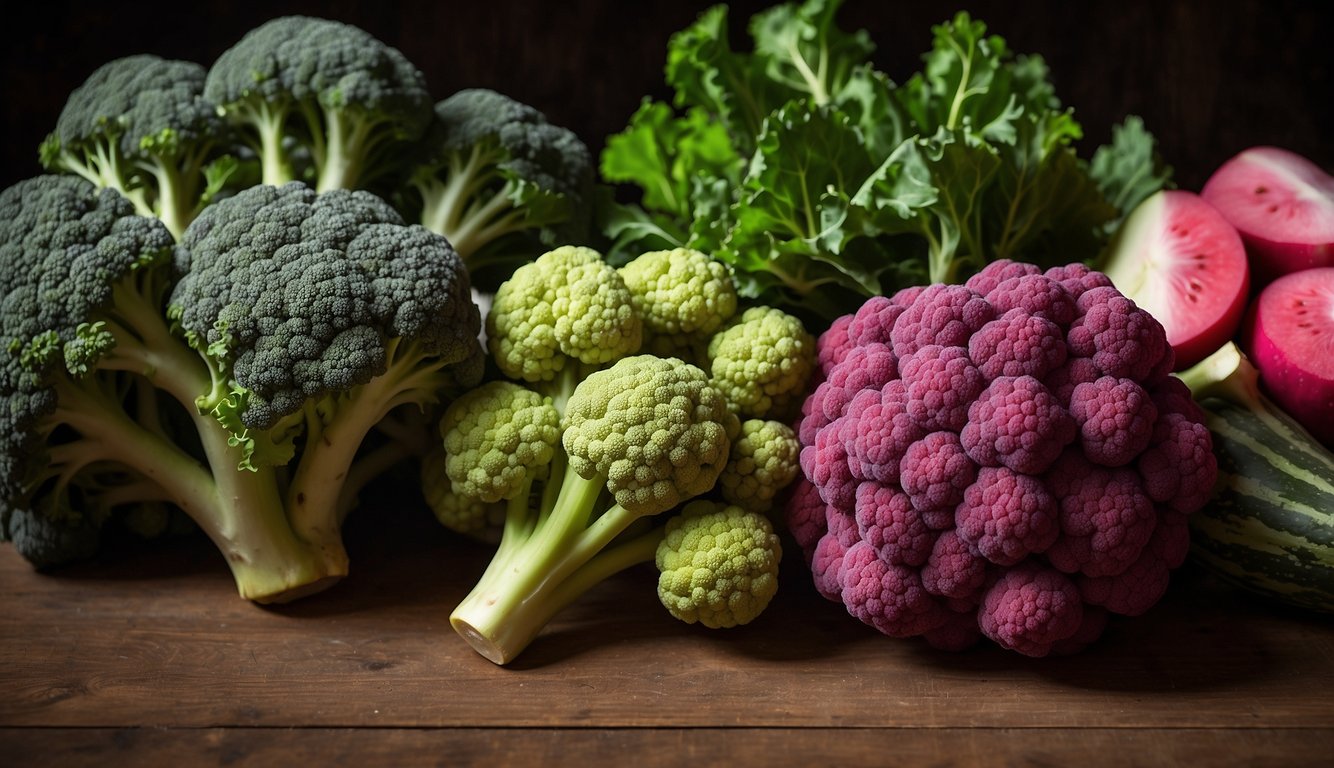TheHerbProf.com is a treasure trove of knowledge for those interested in natural healing and herbal remedies. The website is run by Paul Johnston MD. A naturopathic who has not only received extensive education in the field but also has personal experience in self-healing.
As someone who loves to cook and experiment with new flavors, I’m always on the lookout for unusual vegetables to add to my meals. While staples like carrots, broccoli, and potatoes are great, there’s a whole world of lesser-known veggies out there that are just waiting to be discovered. Whether you’re a seasoned cook or just looking to switch up your usual routine, incorporating unusual vegetables into your meals can be a fun and exciting way to expand your culinary horizons.
One of the benefits of trying out new vegetables is that they often come with unique flavors and textures that can add depth and complexity to your dishes. For example, have you ever tried sunchokes, also known as Jerusalem artichokes? These knobby little tubers have a nutty, slightly sweet flavor and a crispy texture that makes them perfect for roasting or frying. And then there’s kohlrabi, a member of the cabbage family that has a mild, slightly sweet taste and a crunchy texture that’s perfect for salads and slaws. By branching out from the usual suspects and trying out some of these unusual vegetables, you can add new dimensions to your meals and discover new favorite ingredients.
Understanding Unusual Vegetables
As a gardening enthusiast, I have always been fascinated by the variety of vegetables available in the market. While most of us are familiar with the common vegetables like carrots, potatoes, and tomatoes, there are many others that are less known and often considered unusual or exotic.
Unusual vegetables are those that are not commonly found in grocery stores or farmer’s markets. They are often grown locally and have unique flavors, textures, and nutritional values. Some of these vegetables are native to specific regions or countries, while others have been introduced through cross-breeding or hybridization.
One of the reasons why unusual vegetables are gaining popularity is because of their exotic nature. People are always looking for new and exciting foods to try, and unusual vegetables offer just that. They are also great conversation starters and can be used to impress guests at dinner parties.
Another reason why unusual vegetables are worth exploring is their nutritional value. Many of these vegetables are packed with vitamins, minerals, and antioxidants that are essential for good health. For instance, purple carrots contain anthocyanins, which are powerful antioxidants that protect against cancer and heart disease. Similarly, kohlrabi is rich in vitamin C, fiber, and potassium, which are all essential for maintaining good health.
Unusual vegetables are a great way to add variety and excitement to your diet. They are not only delicious but also offer a range of health benefits. If you are looking to try something new, I encourage you to explore the world of unusual vegetables and discover the many flavors and textures they have to offer.
Root and Tuber Varieties – Unusual Vegetables

As a lover of unusual vegetables, I am always on the lookout for new and exciting root and tuber varieties to add to my garden and meals. In this section, I will introduce you to some of my favorite root and tuber varieties that are sure to add some unique flavors and textures to your dishes.
Oca – Unusual Vegetables
Oca, also known as New Zealand yam, is a root vegetable that is native to South America. It has a sweet, tangy flavor that is reminiscent of lemon and can be eaten raw or cooked. Oca is also a great source of vitamin C and potassium. It can be boiled, roasted, mashed, or fried and is a great addition to salads, stews, and stir-fries.
Celeriac
Celeriac, also known as celery root, is a knobby root vegetable that is related to celery. It has a mild, sweet, and nutty flavor and can be eaten raw or cooked. Celeriac is a great source of fiber, vitamin K, and phosphorus. It can be boiled, roasted, mashed, or pureed and is a great addition to soups, stews, and gratins.
Salsify
Salsify, also known as oyster plant, is a root vegetable that is native to Europe. It has a delicate, sweet, and earthy flavor that is similar to oysters and can be eaten raw or cooked. Salsify is also a great source of fiber, iron, and potassium. It can be boiled, roasted, mashed, or fried and is a great addition to soups, stews, and salads.
Jerusalem Artichoke – Unusual Vegetables
Jerusalem artichoke, also known as sunchoke, is a tuber that is native to North America. It has a sweet, nutty, and slightly earthy flavor and can be eaten raw or cooked. Jerusalem artichoke is also a great source of fiber, iron, and potassium. It can be boiled, roasted, mashed, or pureed and is a great addition to soups, stews, and stir-fries.
Jicama
Jicama, also known as Mexican turnip, is a root vegetable that is native to Mexico. It has a crisp, juicy, and slightly sweet flavor and can be eaten raw or cooked. Jicama is also a great source of fiber, vitamin C, and potassium. It can be sliced, diced, or grated and is a great addition to salads, slaws, and salsas.
Kohlrabi
Kohlrabi is a root vegetable that is native to Europe and Asia. It has a mild, sweet, and slightly nutty flavor and can be eaten raw or cooked. Kohlrabi is also a great source of fiber, vitamin C, and potassium. It can be boiled, roasted, mashed, or grated and is a great addition to soups, stews, and salads.
These root and tuber varieties are just a few examples of the many unusual vegetables that are available to us. They offer a range of unique flavors, textures, and health benefits that are sure to add some excitement to your meals.
Leafy Greens and Stems – Unusual Vegetables
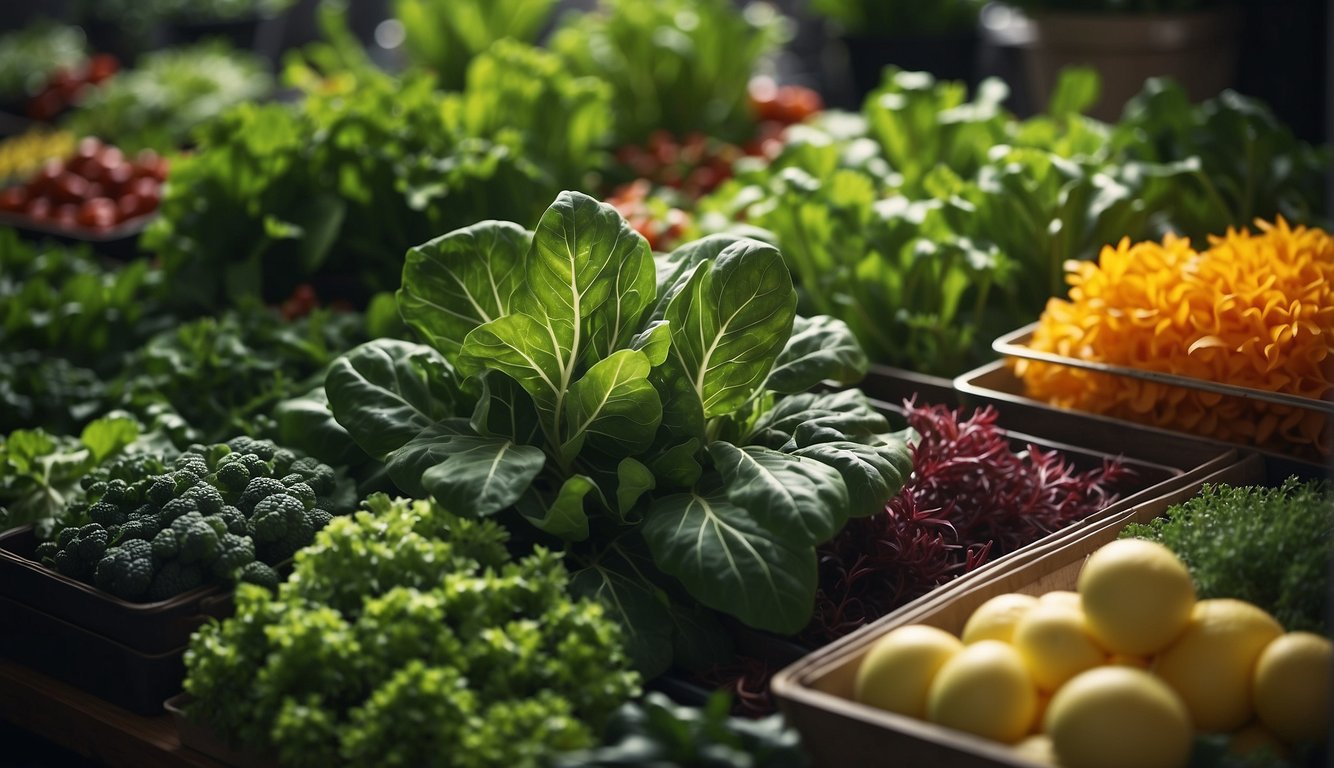
As a vegetable enthusiast, I’m always on the lookout for unusual greens to add to my garden. In this section, I’ll introduce you to three unique leafy greens and stems that are sure to add some excitement to your meals.
Romanesco Broccoli – Unusual Vegetables
Romanesco broccoli is a mesmerizing vegetable that looks like it’s from outer space. Its bright green, cone-shaped heads are made up of a series of smaller spirals, giving it a unique and striking appearance.
But Romanesco isn’t just a pretty face – it’s also packed with nutrients. Like other members of the broccoli family, Romanesco is high in vitamin C, antioxidants, and vitamin K. It’s also a good source of iron.
When it comes to cooking, Romanesco is versatile. You can roast it, steam it, or eat it raw. Its tender texture and nutty flavor make it a great addition to salads, stir-fries, and pasta dishes.
Kale
Kale has been a trendy vegetable for a while now, but there are still a few varieties that are lesser-known. For example, have you ever tried dinosaur kale? It has a darker, bluer hue than regular kale and a slightly sweeter taste. Or what about red Russian kale? It has a purplish-red stem and a more delicate flavor than other kale varieties.
No matter which kale you choose, you’ll be getting a powerhouse of nutrients. Kale is high in vitamins A, C, and K, as well as antioxidants. It’s also a good source of fiber.
Kale is a versatile vegetable that can be eaten raw or cooked. You can use it as a base for salads, blend it into smoothies, or sauté it with garlic and olive oil.
Fiddleheads – Unusual Vegetables
Fiddleheads are the curled-up fronds of young ferns, and they’re a delicacy in many parts of the world. They have a unique flavor that’s often described as a cross between asparagus and green beans.
Fiddleheads are high in antioxidants and a good source of vitamin C. They’re also a good source of iron and other minerals.
When preparing fiddleheads, it’s important to blanch them first to remove any bitterness. After blanching, you can sauté them with butter and garlic or add them to soups and stews.
These unusual leafy greens and stems are not only visually appealing but also packed with nutrients. Incorporating them into your diet is an easy way to add some variety and excitement to your meals.
Exotic and Tropical Varieties – Unusual Vegetables
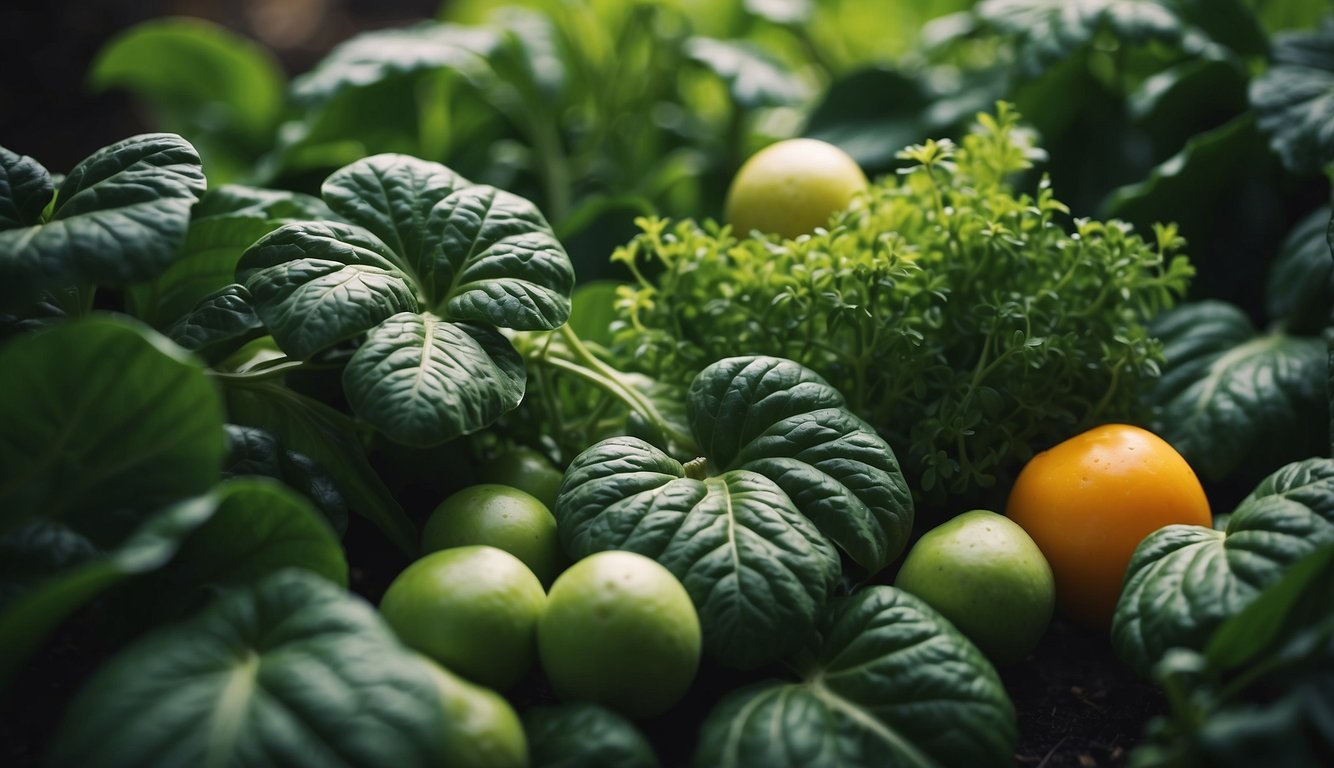
When it comes to unusual vegetables, exotic and tropical varieties are always a great choice. These vegetables are often packed with unique flavors, textures, and nutrients, making them a great addition to any dish. In this section, I will introduce you to some of my favorite exotic and tropical vegetables.
Chayote
Chayote is a pear-shaped vegetable that is native to Central America and Mexico. It has a mild, slightly sweet taste and a texture that is similar to a cross between a potato and a cucumber. Chayote is a great source of fiber and vitamin C, and it can be boiled, baked, or fried.
Nopal – Unusual Vegetables
Nopal, also known as prickly pear cactus, is a vegetable that is commonly eaten in Mexico and other parts of Central and South America. It has a slightly bitter taste and a succulent texture. Nopal is packed with vitamins and minerals, including vitamin C, magnesium, and potassium. It can be eaten raw or cooked, and it is often used in salads, stews, and soups.
Taro
Taro is a root vegetable that is popular in Southeast Asia and the Pacific Islands. It has a starchy texture and a mildly sweet taste. Taro is a great source of fiber, potassium, and vitamin E. It can be boiled, mashed, or fried, and it is often used in soups, stews, and curries.
Yardlong Beans
Yardlong beans, also known as Chinese long beans, are a type of legume that is native to Asia. They have a slightly sweet taste and a crisp, crunchy texture. Yardlong beans are a great source of protein and fiber, and they can be stir-fried, boiled, or steamed.
Shiso – Unusual Vegetables
Shiso, also known as perilla, is a herb that is native to Asia. It has a spicy, minty flavor and a slightly bitter taste. Shiso is a great source of vitamins and minerals, including vitamin A and calcium. It can be used in salads, soups, and sushi rolls, and it is often used as a garnish.
These are just a few examples of the many exotic and tropical vegetables that are available. Whether you are looking for something spicy, mildly sweet, or bitter, there is sure to be a vegetable that will suit your tastes.
Uncommon Fruit-Like Vegetables
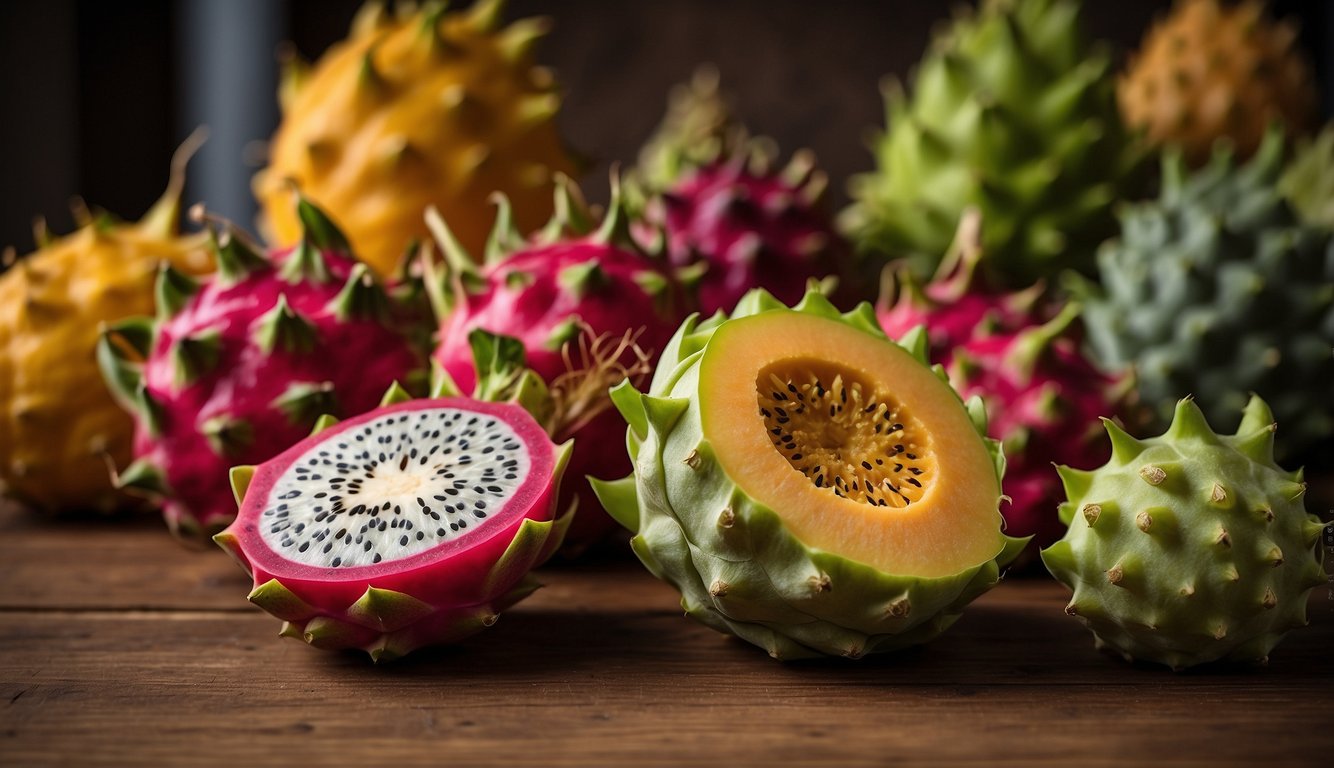
As a vegetable enthusiast, I am always on the lookout for unique and flavorful options to add to my meals. In this section, I will introduce you to three uncommon fruit-like vegetables that are sure to add some excitement to your dishes.
Tomatillo
Tomatillos are small, round, green fruits that are encased in a papery husk. Although they look like small green tomatoes, they have a distinctly tart flavor that sets them apart. They are commonly used in Mexican cuisine to make salsa verde, but they can also be roasted or grilled for a smoky flavor. Tomatillos are rich in antioxidants and potassium, making them a nutritious addition to any meal.
Purple Sweet Potato – Unusual Vegetables
Purple sweet potatoes are a colorful and tasty alternative to traditional sweet potatoes. They have a vibrant purple flesh that is rich in fiber and antioxidants. Purple sweet potatoes have a sweet flavor that is perfect for roasting, mashing, or baking. They can also be used in salads or stir-fries to add a pop of color and flavor.
Watermelon Radish
Watermelon radishes are a unique and colorful variety of radish that are shaped like a small turnip. They have a green and white exterior, but when sliced open, they reveal a bright pink interior that resembles a watermelon. Watermelon radishes have a mild flavor that is slightly sweet and peppery. They are perfect for adding color and crunch to salads, sandwiches, and stir-fries.
Overall, these uncommon fruit-like vegetables are a great way to add some variety and nutrition to your meals. Whether you are looking for sweet flavor or vibrant colors, these vegetables are sure to impress.
Nutritional Profiles of Unique Vegetables
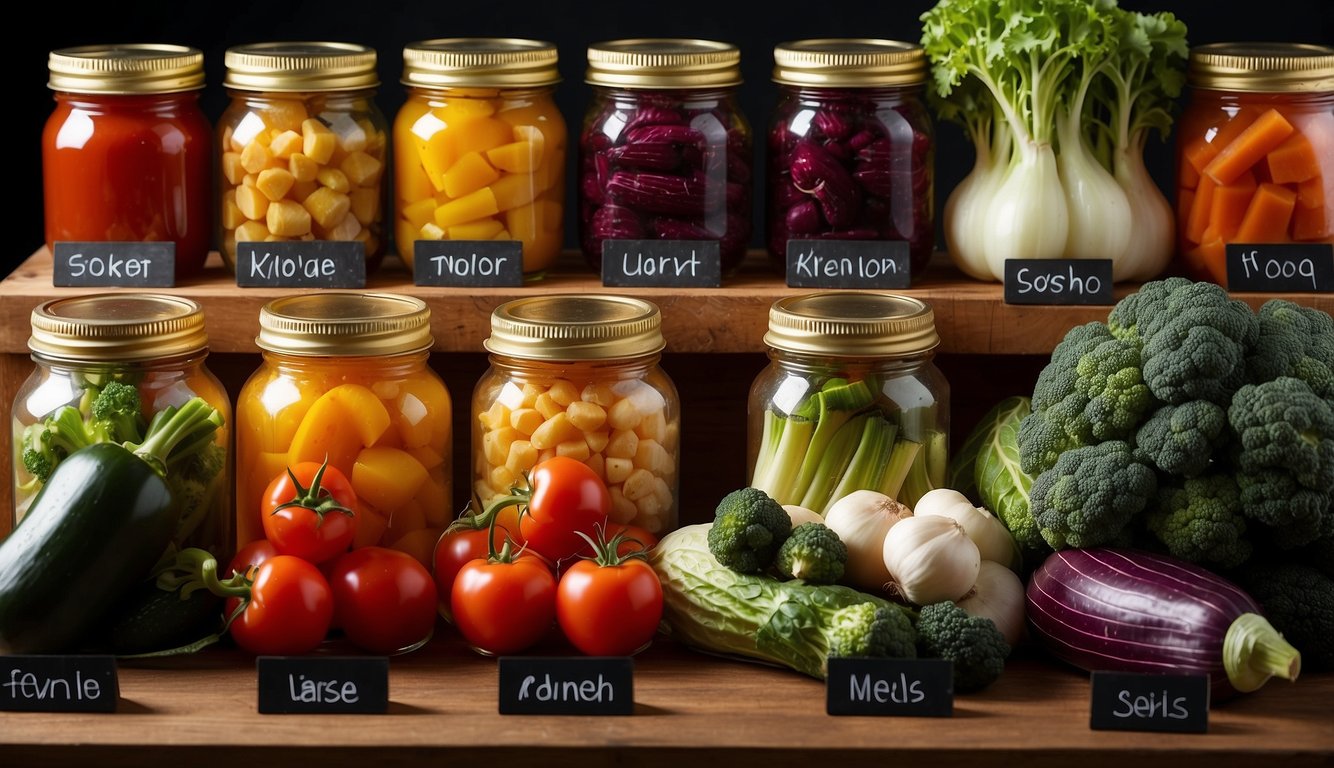
As a nutritionist, I always recommend incorporating a variety of vegetables into your diet to ensure you are getting a wide range of nutrients. While most people are familiar with common vegetables like broccoli, carrots, and spinach, there are many unique vegetables that are often overlooked. In this section, I will provide some information on the nutritional profiles of a few of these unique vegetables.
Daikon Radish
Daikon radish is a winter radish often used in Asian dishes. It is a good source of vitamin C, which is important for immune function and skin health. Daikon radish also contains antioxidants, which can help protect your cells from damage caused by free radicals. Additionally, it is low in calories and high in fiber, which can help keep you feeling full and promote digestive health.
Kohlrabi – Unusual Vegetables
Kohlrabi is a unique vegetable that is part of the cabbage family. It is a good source of potassium, which is important for maintaining healthy blood pressure and heart function. Kohlrabi is also high in fiber, which can help promote digestive health and keep you feeling full. Additionally, it contains vitamin C and antioxidants, which can help protect your cells from damage.
Winged Beans
Winged beans, also known as four-angled beans, are a unique bean variety with an angled shape. They are a good source of iron, which is important for healthy red blood cells and energy production. Winged beans are also high in fiber, which can help promote digestive health and keep you feeling full. Additionally, they contain omega-3 fatty acids, which are important for heart health.
Watermelon Radish – Unusual Vegetables
Watermelon radish is a unique radish variety that is named for its pink flesh, which resembles watermelon. It is a good source of vitamin C, which is important for immune function and skin health. Watermelon radish also contains antioxidants, which can help protect your cells from damage caused by free radicals. Additionally, it is low in calories and high in fiber, which can help keep you feeling full and promote digestive health.
Incorporating unique vegetables like these into your diet can provide a range of nutrients and health benefits. Be sure to experiment with different vegetables to find ones that you enjoy and that fit your dietary needs.
Culinary Uses and Preparation Of Unusual Vegetables

As someone who loves to experiment with unique vegetables, I’ve found that there are many exciting ways to incorporate them into meals. Here are some of my favorite culinary uses and preparation tips for unusual vegetables.
Salads and Raw Dishes
Unusual vegetables can add an interesting twist to salads and other raw dishes. For example, kohlrabi, with its sweet and nutty flavor, makes a great addition to salads when shaved thinly. I also love using jicama, which has a slightly sweet and juicy flesh, in salads for a refreshing crunch. Other great options include celeriac, which has a subtle celery flavor and a tender texture, and mizuna, a Japanese green with a peppery taste.
Cooked Dishes and Stir-Fries – Unusual Vegetables
Many unusual vegetables are perfect for cooked dishes and stir-fries. For example, salsify, a root vegetable that tastes similar to oysters, can be boiled, roasted, or sautéed and used in soups, stews, or stir-fries. Another great option is celtuce, a Chinese lettuce with a mild and slightly nutty flavor that can be stir-fried with garlic, ginger, and soy sauce. And for those who love spicy food, the Korean vegetable called shishito pepper can be stir-fried with a spicy sauce for a delicious and fiery dish.
Pickling and Preserving
Pickling and preserving are great ways to extend the life of unusual vegetables and add some interesting flavors to your dishes. For example, pickled ramps, a wild onion that is only available in the spring, can add a tangy and oniony flavor to sandwiches, salads, and other dishes. Another great option is pickled fiddlehead ferns, which have a delicate and tender texture and a slightly sweet flavor. And for those who love autumn and winter vegetables, pickled kohlrabi or celeriac can add a tangy and crunchy element to any dish.
Overall, there are many ways to incorporate unusual vegetables into your meals. Whether you prefer salads, stir-fries, or pickled vegetables, there is something out there for everyone. So don’t be afraid to try something new and experiment with these unique and delicious ingredients!
Growing Unusual Vegetables

As an avid gardener, I always enjoy experimenting with new and unusual vegetables. While many people stick to the tried and true classics, there are a plethora of unique and interesting options out there that can add variety and excitement to your garden and your plate. In this section, I will cover the key factors to keep in mind when growing unusual vegetables, including their climatic requirements, soil and fertilization needs, and pest and disease management.
Climatic Requirements
One of the most important factors to consider when growing unusual vegetables is their climatic requirements. Many of these plants come from specific regions around the world, and may require specific temperature, humidity, and light conditions in order to thrive. For example, fiddleheads, which are the unfurled tops of ostrich ferns, are native to cool and moist areas of North America and the Mediterranean. On the other hand, gourds and pumpkins, which are often grown for their decorative value as well as their edible flesh and seeds, thrive in hot and humid climates.
Soil and Fertilization – Unusual Vegetables
Another key factor to consider when growing unusual vegetables is soil and fertilization. Fertile soil is crucial for the growth and development of all plants, but some unusual vegetables may have specific soil requirements. For example, summer squash and zucchini prefer well-drained soil with a pH between 6 and 7, while peppers and tomatoes prefer slightly acidic soil with a pH between 5.5 and 6.5. Additionally, some unusual vegetables may require specific fertilization techniques, such as the use of organic compost or the addition of specific nutrients like nitrogen or potassium.
Pest and Disease Management
Finally, it is important to consider pest and disease management when growing unusual vegetables. While many of these plants may be less susceptible to common pests and diseases than more widely grown vegetables like carrots, cabbage, cauliflower, celery, and spinach, they may still face specific challenges. For example, some unusual vegetables like the Andean root vegetable oca may be vulnerable to damage from slugs and snails, while others like the Italian heirloom tomato San Marzano may be prone to blossom-end rot. It is important to research the specific pests and diseases that may affect your chosen unusual vegetables, and to take steps to prevent and manage them using organic and sustainable methods.
By keeping these factors in mind and doing your research, you can successfully grow a wide range of unusual and unique vegetables in your garden. Whether you are looking to try new flavors and textures, or simply add some visual interest to your garden, there are plenty of options to choose from.
Unusual Vegetables and Their Symbiotic Relationships
Let’s unearth the secrets of unusual vegetables and their symbiotic relationships.
First up, we have the dynamic duo of nasturtiums and cucumbers. Nasturtiums are not just pretty faces, they’re also great at warding off cucumber beetles!
Next, let’s talk about carrots and leeks. These two are like two peas in a pod. Leeks repel carrot flies, and carrots return the favor by deterring leek moths. Talk about teamwork!
Ever heard of horseradish and potatoes? Planting horseradish near potatoes can protect the spuds from Colorado potato beetles. Now that’s a spicy solution!
And let’s not forget the classic combo of roses and garlic. Garlic helps to repel rose pests, and roses… well, they just look beautiful!
Remember, in the garden, as in life, we’re better together. So, let’s keep digging, keep planting, and keep enjoying the fruits (and vegetables) of our labor!
For more plant wisdom, swing by my homepage at theherbprof.com. Keep those green thumbs up!
References – Unusual Vegetables
Little Herb Encyclopedia, by Jack Ritchason; N.D., Woodland Publishing Incorporated, 1995
The Ultimate Healing System, Course Manual, Copyright 1985, Don Lepore
Planetary Herbology, Michael Tierra, C.A., N.D., Lotus Press, 1988
Handbook of Medicinal Herbs, by James A. Duke, Pub. CRP Second Edition 2007
The Complete Medicinal Herbal, by Penelope Ody, Published by Dorling Kindersley
Check the Following Articles!
Grow Your Own Food from Scraps: Sustainable Garden
Can You Plant Garlic in the Spring? Tips and Guidelines
Unique Vegetables: Exploring Uncommon Varieties
Frequently Asked Questions – Unusual Vegetables
What are some exotic vegetables that are uncommon in everyday cuisine?
There are many exotic vegetables that are not commonly found in everyday cuisine. Some examples include kohlrabi, celeriac, and salsify. These vegetables have unique flavors and textures that can add variety to your meals.
Can you name a few unusual vegetables that can be grown in a home garden?
Yes, there are plenty of unusual vegetables that can be grown in a home garden. Some examples include purple carrots, rainbow chard, and Romanesco broccoli. These vegetables not only add visual interest to your garden but also provide a healthy and delicious addition to your meals.
What are some unique root vegetables that are not typically found in grocery stores?
There are many unique root vegetables that are not commonly found in grocery stores. Some examples include burdock root, lotus root, and sunchoke. These root vegetables have a variety of health benefits and can add unique flavors and textures to your meals.
Could you provide a list of vegetables that have funny or unexpected names?
Sure, there are many vegetables with funny or unexpected names. Some examples include dragon tongue beans, rat-tail radish, and cucamelon. These vegetables may sound strange, but they are all delicious and worth trying.
Which vegetables are considered rare or exotic around the world?
There are many vegetables that are considered rare or exotic around the world. Some examples include yacón, oca, and taro. These vegetables are not commonly found in most grocery stores but can be found at specialty markets or grown in a home garden.
Are there any weird vegetables that are often mistaken for other types of produce?
Yes, there are some weird vegetables that are often mistaken for other types of produce. For example, jicama is often mistaken for a potato or turnip, but it is actually a root vegetable with a unique flavor and texture. Another example is kohlrabi, which is often mistaken for a turnip or radish, but it is actually a member of the cabbage family.
